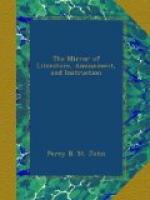[5] Le Brun was the pupil of Simon Voueet, and afterwards of Poussin.
After Le Brun’s death, which took place in 1690, the French artists degenerated greatly, their productions being decorated in a gaudy and theatrical way, without due regard to taste or decorum. Their school, some years ago, altered its principles, under the auspices of the spirited Count de Caylus, who possessed considerable merit as an artist. The count, by his high rank and fortune, had the means of encouraging the imitators of the ancients, and of procuring the best models in Italy for study. He, in conjunction with Monsieur Vien, first formed the design of restoring a pure taste in France; and if his countrymen had followed the path thus marked out for them, they would now have been equal to the greatest of the Greek painters. But it appears that they are incapable of rising to any very extraordinary height in the arts, for, with the exception of Le Seur, and one or two others, they have ever wanted that elevation of mind which so eminently distinguished the Romans. Though De Caylus greatly purified painting in his time, yet his precepts and examples had little or no weight after his death, for the art again retrograded into its original state—a state from which the French professors, as before observed, seem incapable of rising.
In our own days some few French artists have distinguished themselves, particularly Lefevre, who was the chief painter to Napoleon. A full-length portrait of the emperor in his coronation robes, for which Lefevre received the sum of five thousand Napoleons, and which I have lately had the pleasure of seeing, is very correct in drawing, and extremely rich and harmonious in colour; but it wants freedom and boldness of execution.
To conclude—the French are acknowledged to do pretty well within the precincts of their own country, though few of their pictures will stand in competition with those of the Italians, or with those produced in our own school.
G.W.N.
* * * * *




